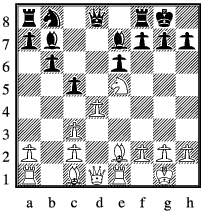
April 2010
Booked into hotel. Now what? Exmouth has a nice sandy beach reaching east to some sandstone cliffs and continuing beneath them. Onto the beach and to the cliffs. Round a corner of the cliffs on which is fixed a notice of warning of danger of being cut off by incoming tide, and kept going. It becomes apparent that there is a path leading upwards from the far end of the beach, so relieved of worry we continue and climb the path, pass through a holiday park and follow the coast path onto the cliffs beyond. This is sufficiently muddy that for the second time today I miss my walking shoes, but not so bad as to make us turn back.
From a vantage point at the end of the holiday park we can see all the way to Budleigh Salterton and beyond. A shingle beach follows the foot of the cliffs, but this is crossed in a couple of places by red earth that has clearly tumbled down the cliffs during some recent landslide. Further on on our path there is indeed a notice warning of recent landslip, and without approaching too close to the edge it is possible to see what appears to be several vegetation covered areas which look to have slid downhill to various degrees, some carrying the remains of fences. We can also see that at the edge the clifftop is undercut, so falling over would not be difficult. The discreet warning notice is the only nod in the direction of 'elf and safety here. Each man should look out for himself.
By the time we reach the highest point (just over 400 feet) there is enough gorse and bramble between the path and the cliff edge to dissuade one from going to the latter. Indeed there are a few secluded spots we pass where I alarm Alex by remarking that they are perfect places to commit a murder and conceal the body.
Passing a golf course we descend into Budleigh and take a bus back to Exmouth. A pleasant enough interlude between journey and start of chess.
comment on this article
Round 1, and RR finds himself as the higher graded player on board seven. Methinks this makes me the seventh seed. Black against Keith Atkins who plays for Sedgemoor (Bridgewater).

|
| Keith Atkins v RR after 10 Bb7 |
11 ... Qc8, 12 d5 Rd8, 13 c4 exd5
14 cxd5 Bf6, 15 Bg4 Qc7, 16 Bf4
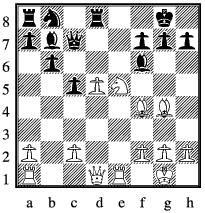
|
| Keith Atkins v RR after 16 Bf4 |
16 ... Bxd5, 17 Nd7 (c4 better) Qxf4, 18 Nxf6+ Qxf6 (gxf6 better as with no back rank mate threat the bishop is protected and RR emerges a piece and pawn to the good - Bf3 by white can be met by Qg5. However a pawn and a better pawn structure will do for RR).
The remainder of the game was hardly flawless, but RR negotiated it without fatal error:
19 Qxd5 Nc6, 20 Qe4 Rab8, 21 Rad1 g6, 22 Bf3 Nd4
23 Bg4 h5, 24 Bh3 Kf8, 25 c3 Re8, 26 Qd5 Ne2+
27 Kf1 Nxc3, 28 Rxe8+ Rxe8, 29 Qd6+ Qxd6, 30 Rxd6 Nxa2
31 Rd7 Re7, 32 Rd8+ Kg7, 33 Ra8 c4, 34 Rc8 c3
35 Rc4 b5, 36 Rc5 b4 0-1
One round down and I have achieved my first and most modest target - get off the mark to avoid an early forced bye should there be an odd number of players. My remaining targets will take longer to achieve:
The lower of 50% and reaching a score guaranteeing a congress performance of at least my grade,
The higher of the aforementioned scores,
A prize.
After 14 moves the spectators were already nodding off.
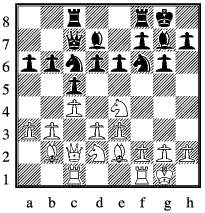
|
| RR v John Gorodi after 14 N(g5)e4 |
Hoping that a pawn on d5 resulting from an exchange of knights will have a significant cramping effect, and may even become passed in time. John is content to play the black side of such a position:
18 ... Nxd5, 19 cxd5 Qd8, 20 Qd1 Qe7, 21 Rc2 b5
22 e4 Bh6, 23 Bc3 f5, 24 Be1 g5, 25 Bd2
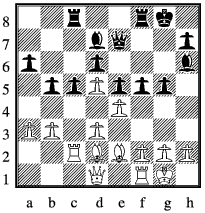
|
| RR v John Gorodi after 25 Bd2 |
25 ... f4, 26 Bg4 Bye-bye white squared bishops. Reckon I'm ahead now.
26 ... Bxg4, 27 Qxg4 Qf7, 28 Rfc1 Rc7, 29 Ba5 Rb7, 30 b4 f3
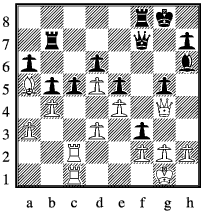
|
| RR v John Gorodi after 30 ... f3 |
31 g3 Qd7, 32 Qxd7 Rxd7, 33 bxc5 dxc5, 34 Rxc5 g4
35 R1c2 Re8, 36 Rc6 Bf8, 37 Rc8 (R2c3 better)
37 ... Rxc8, 38 Rxc8 Kf7, 39 Rc3 Rb7, 40 Kf1 At the time I suspected that resolving the position on the kingside first with h3 might be sensible, but as you can see I elected to bring the king across to the queenside immediately.
40 ... b4, 41 axb4 Bd6
A surprising refusal to recapture:
41 ... Bxb4, 42 Rb3 Rb5 and either
43 Rxb4 Rxa5 or 43 Bxb4 a5 and black has a useful outside passed pawn.
I give the remainder of the game without comment, not because nothing of note happened, but because I wish to complete my weekend report sometime in the not too distant future.
42 Rc4 Ke7, 43 Ke1 Kd7, 44 Kd2 Rb8, 45 Kc3 h5
46 d4 h4, 47 Kd3 hxg3, 48 hxg3 Rh8, 49 dxe5 Bxe5
50 Bb6 Rh1, 51 Rc6 Rd1+, 52 Kc2 Re1, 53 Rc4 Re2+
54 Kd1 Ra2, 55 Be3 Bxg3, 56 fxg3 f2, 57 Bxf2 Rxf2
58 e5 Rf3, 59 d6 Rxg3, 60 Rc7+ Kd8, 61 Ke2 Rh3
62 e6 Rh2+, 63 Kf1 1-0
A fair days work is made even better when I discover that I am the only one of the 30+ players in the section to reach 2/2. Congresses aren't just about the chess, and we spent the evenings in the company of Brendan O'Gorman dining, drinking a little and studying action replays of our games, with special attention to the might-have-happened.
comment on this article
Indeed as is his wont RR spent much of the first half of the game under pressure with a knight on the rim at a5 doing its best not to be dim from move 13 onwards. We join the game much later, just before the critical point.
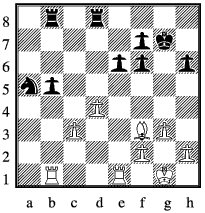
|
| Ivor Annetts v RR after 30 cxb5 |
31 Rb4 Rdc8, 32 Rc1 Nc4, 33 Be2 Nd6, 34 c4 with offer of draw.
The offer was made in such a way that it was clear that Ivor was unaware that he had just blundered a pawn. RR declined the offer:
34 ... bxc4, 35 Rxb8 Rxb8 and white cannot take on c4 with the bishop because of the pinning reply of Rc8.
The rest as the saying goes was technique, even if the technique was a bit dodgy in places. The resignation came instead of a move 59.
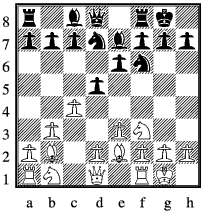
|
| RR v Julian Taylor after 7 0-0 |
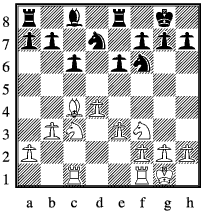
|
| RR v Julian Taylor after 15 Bxc4 |
RR is more than happy to remove the knights - blacks is his only piece with any freedom.
22 Nxd7 Rxd7, 23 Be4 f5, 24 Bf3 g5, 25 Rfc1 Rdc7
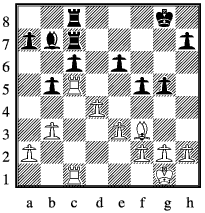
|
| RR v Julian Taylor after 25 ... Rdc7 |
It is apparent that I cannot increase the pressure on the queenside further, so I should now be opening up the centre with e4. However I elect first to defend the h-pawn and then support the b-pawn. By the time I get to making the central break black has placed his rook in a better spot.
36 R1c2 Rh6, 37 a4 Rh7, 38 a5 Re7, 39 Re5 Rf7
40 Bh1 Rf6, 41 Rec5 Rf7, 42 e4 f4, 43 gxf4 Rxf5
44 Rg5 Rcf8, 45 Bg2 R8f7. I'd like to remove the rooks. Can't believe he'll want me around the back. e5+ would probably be better, but he is more likely to keep a pair of rooks on that way. So
46 Rg8
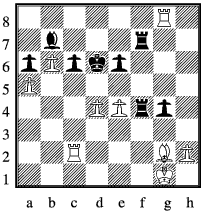
|
| RR v Julian Taylor after 46 Rg8 |
First up Jon Duckham (Tiverton).
This was a nearly game, notable for the players inability to come up with a telling plan in the queenless middlegame. One of the bigger decisions to make for RR was towards the end - see diagram.
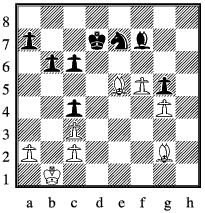
|
| Jon Duckham v RR after 32 Bxe5 |
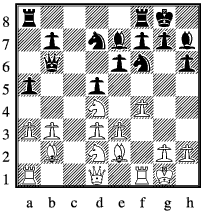
|
| RR v Peter Jaszkiwsky after 13 ... Qb6 |
14 Kh1 Nc5, 15 N2f3 Nfd7, 16 Rb1 Rac8, 17 g4 Qa6
18 Ne1 Bh4, 19 Ndf3 Bxe1, 20 Nxe1 Qb6, 21 Bd4 (b4 better as it resolves the queenside position. There is no question of black winning the pawn:
22 axb4 axb4, 23 Qxb4 bxg7)
21 ... Qd6, 22 Nf3
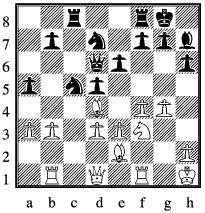
|
| RR v Peter Jaszkiwsky after 22 Nf3 |
2 ... a4, 23 b4 No! Takes, and life is comfortable.
23 ... Nb3, 24 Rg1 Blacks b3 knight is doing remarkably little, so better to remove my bishop from the firing line.
24 ... Nxd4, 25 Nxd4 e5, 26 fxe5 Qxe5, 27 Rg3 Qc7
Time now to say a pawns a pawn and remove the a4 animal from circulation. However I'm feeling disconcertingly exposed (unnecessary feeling) and so am in attack at all costs mode. Silly.
28 g5 hxg5, 29 Rxg5 Nf6, 30 Qg1 Bg6
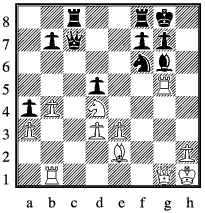
|
| RR v Peter Jaszkiwsky after 30 ... Bg6 |
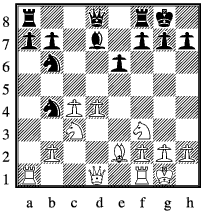
|
| John Nyman v RR after 12 ... Bd7 |
17 Qd2 Rfd8, 18 Ra3 Bb5, 19 Rc1 Nc6, 20 Nd6 Nxe5
21 dxe5 Bc6, 22 Bh5 Rf8, 23 Rg3 Kh8, 24 Rc4 f5
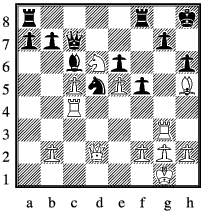
|
| John Nyman v RR after 21 ... f5 |
It is worth pointing out that we are now both running short of time having maybe two or three minutes for six moves to the intermediate time control.
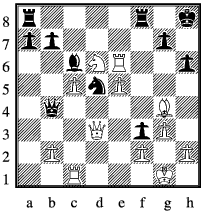
|
| John Nyman v RR after 30 ... Qb4 |
31 ... Nf4, 32 gxf4 Qxf4, 33 Rc3 removing it from attack by the queen and providing further support to the bishop, though Rc4 would be much better.
33 ... Qg5+, 34 Kf1 Bxf3, 35 Qg6 Qd2, 36 Rxf3 Qd1+ and the time control is made with what appears to be a combined total of less than 20 seconds on the clock. White can be forgiven for playing on as he will still have a central passed pawn for the exchange and hopes perhaps that removing the queens can lead to another turn in fortunes.
37 Kg2 Qxf3+, 38 Kg1 Qxf2+, 39 Kh1 Qe1+, 40 Kg2 Qf1+
41 Kg3 Qf2+ missing the mate in two starting Rf3+, but John has had enough anyway. 0-1
On the adjacent board Peter J looked to be having the worse of a draw, so it came to pass that RR was the outright winner of the section.
comment on this article
First division
| ||||||||||||||||||||||||||||||||||||||||||||||||||||||||||||
Second division
| ||||||||||||||||||||||||||||||||||||||||||||||||||||||||||||
Third division
| ||||||||||||||||||||||||||||||||||||||||||||||||||||||||||||
Fourth division
| ||||||||||||||||||||||||||||||||||||||||||||||||||||||||||||
Fifth division
|
The fixtures were designed so that only the largest divisions, 2 and 5, need to continue beyond this point. But that was not taking into account the great British weather which this winter has elected to be particularly bad on Wednesdays and Fridays. Consequently there is still some tidying up to do in the other divisions too.
Holmes Chapel Kings have been confirmed as first division champions, whilst Stafford A prop up the table despite picking up a belated win.
Cheddleton B and defending champions Macclesfield both lost their first matches of the season in March, but with Macclesfield also racking up draws Cheddleton B must now be considered favourites, though not yet hot ones.
Between them the Newcastle teams won all five matches played, and this enabled the C team to bridge the gap that had separated the top and bottom halves of the division. The prominent gap now is that which separates the bottom three from the rest, and I feel safe in predicting that this gap will not be closed.
Although Meir currently top the pile my 1-2-3 predictions are Cheddleton, Macclesfield and Newcastle B.
The Cheddleton teams have led division three from start to (near) finish, their C team being safely ensconced as at least joint champions with only their D team able to join them.
Fenton C are the leagues only unbeaten team, and are clear winners of division four, so far conceding just two draws. Despite Fenton's dominance, the fourth is also the only division in which all teams have picked up at least a quarter of the points available to them. No whipping boys here.
Fenton in the shape of their D team also sit atop of division five, with games running out for others to catch them. Hassell bring up the rear, but with a selection policy skewed towards spreading league experience around rather than fielding the strongest possible team this is no disgrace.
North Staffs representation has been good within the various county teams, and with the Midlands stages now complete qualification for the national stage is known. And a good picture it is for Staffordshire. The Open team are Midlands Champions, the U160 and U140 sides qualify on split ties as runners up, and the Bulldogs based in the south of the county, are U120 champions. At the U120 level North Staffs players tend to turn out for the Terriers whose series of near misses left them adrift with a single point in the six team table. Yet one game point more in each of their matches and they rather than the Bulldogs would have been champions.
comment on this article
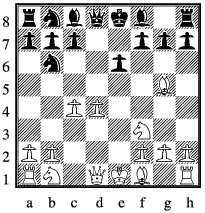
|
| Ian Chester v RR after 6 Bg5 |
6 ... Bb4+, 7 Nc3 Bxc3+, 8 bxc3 f6
(8 ... Qd7, 9 Ne5 Qa4, 10 Qh5 looks rather good for white. Mind you, the text move hardly favours black either!)
9 Bc1 0-0, 10 c5 (generously allowing the knight into the game)
10 ... Nd5, 11 Qc2 No need to protect the c3 pawn.
11 Bd3 Nxc3, 12 Qc2 is clearly good for white.
11 ... Qe7 Black should really be trying to take advantage of white's uncastle position with an immediate e5.
12 Bd3 g6, 13 Bh6 Rf7, 14 h4
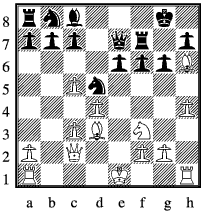
|
| Ian Chester v RR after 14 h4 |
14 ... e5, 15 0-0-0 Bf5 Bg4 is a more obvious attempt to slow the attack.
16 Bxf5 gxf5, 17 Qxf5
(17 dxe5 c6, 18 Qxf5 Na6 - to prevent the unpleasant Qc8+ - allows white to do nasty things to the rook with e6. In this line
18 ... Qe8, 19 e6 Re7, 20 Rh3 with threats down the g-file is no nicer for black)
17 ... Nc6, 18 c4 Nc3, 19 Rd2 exd4 and somehow black has reached a playable position.
20 Qg4+ Kh8, 21 Qh5
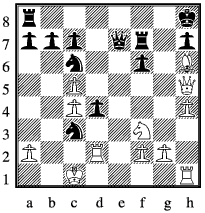
|
| Ian Chester v RR after 21 Qh5 |
22 ... Qg6 fixated on removing the queens, so blind to the merits of Nb4
23 Qxg6 hxg6, 24 Rd2 (A later Nxd4 Nxd4, Rxd4 Ne2+ does not upset black)
24 ... Ne5 (does either player wish to win?)
25 Nxd4 Na4 (Ne4 and take the f-pawn, which isn't defended by the rook because of the other knight)
26 Rc2 Nxc5, 27 Nb3 Ncd3+, 28 Kb1 Nb4, 29 Rc3 Rd8
30 Be3 a6, 31 a3 Nbc6, 32 Kc2 b6, 33 h5 g5
34 f4 Ng4, 35 fxg5 fxg5, 36 Rd1 Nxe3+, 37 Rxe3 Rf2+
38 Rd2 Rdxd2+, 39 Nxd2 Rxg2 and RR has emerged a pawn up with his knight conveniently covering e7.
40 Kc3 Rh2, 41 Rg3 (if the knight is hit with Re6 black first plays Rh3+ to force the white king back and release a square for the aforementioned knight.)
41 ... Rxh5, 42 Ne4 Kg7, 43 Nxg5 Kf6, 44 Ne4+ Ke5
45 Re3 Kf4, 46 Nf6 Ra5, 47 Nd5+ Rxd5 0-1
48 cxd5 Kxe3, 49 dxc6 Ke4 and white cannot save his c-pawn, leaving black with a trivially won ending.
Elsewhere Pete had won quickly, John had salveged a draw from an highly uncomfortable position, and Nic had grabbed defeat from the jaws of victory. This left Paul to offer a draw in a won position (though he may well not have had time to complete the win) to leave us with a 3 - 2 match win.
comment on this article

|
| Steve Hill v RR after 12 ... Rac8 |
13 Ng5 g6 (h6 is more natural, propably more sensible and would definitely have given us a different game. However RR decided to have a dark-coloured escape square for his king to reduce his chances of falling into simple traps involving white's bishop.)
14 Nde4 cxd4, 15 exd4 d5 looking to create an isolated pawn
16 Nxf6+ Nxf6, 17 Qe2 dxc4, 18 Bxc4
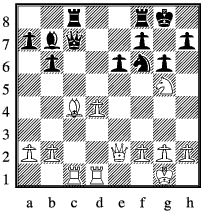
|
| Steve Hill v RR after 18 Bxc4 |
18 ... Bd5, 19 Qe5 Qd8
Kammy: "Its unbelievable Jeff. RR could have won a pawn
19 ... Qxe5, 20 dxe5 Bxc4, 21 exf6 Bxa2
The man who virtually invented the phrase 'win a pawn, win the game' has missed the chance to take a pawn. White's a-pawn should be no more, dead, gone to meet his maker. But RR hasn't taken it."
Jeff: "But wouldn't white then just play Ra1 and win the pawn back?"
Kammy: "No, Jeff. RR now plays Bb3 hitting the other rook. And if Rd3, the bishop retreats to d5 and white still can't take the pawn because of the back rank mate."
20 Ba6 Rxc1, 21 Rxc1 h6, 22 Rc8 Qxc8
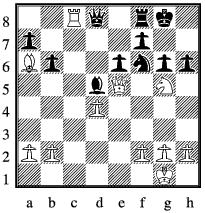
|
| Steve Hill v RR after 22 Rc8 |
23 Bxc8 Rxc8, 24 h3 Rc1+, 25 Kh2 hxg5, 26 Qxf6 Rc2
An unthinking check by white could lead to trouble - he cannot allow his f-pawn to fall because of the resulting weakness of the g-pawn. The basic idea behind the recent exchanges from blacks point of view is that at least one pawn will drop on the queenside and white's queen will have a lot of work to do with no pieces to provide support. There is a small flaw in this.
27 b3
Kammy: "He's hit the woodwork! Its unbelievable Jeff. Steve Hill is getting tired. He reached for the b-pawn, but only had enough energy to move it to the third. What a difference it would have been if he had moved it to the fourth. White wants to mate on g7 with the help of the king. Would RR have noticed in time? Would he have found a way to stop it. I don't know Jeff. I really don't know."
27 ... Rxa2, 28 Kg3 Bxb3, 29 Kg4 Ra5, 30 g3
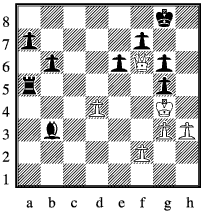
|
| Steve Hill v RR after 30 g3 |
31 h4 gxh4, 32 gxh4 a5, 33 Qe7 b5
Kammy: "Its unbelievable Jeff. My grannie could have taken that pawn. Rxd4+. Simple. RR really is a second division striker Jeff. You've got to score when you're ahead. And he's not. He's obviously fixated on his queenside pawns."
34 Qb4 b5, 35 Kf3 Bc4, 36 Qc3
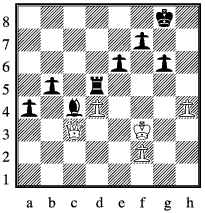
|
| Steve Hill v RR after 36 Qc3 |
Kammy: "Its unbelievable Jeff. RR has missed again. e5 not Rf5+. The d-pawn is pinned against a forking square"
Jeff: "I'm glad I'm not pinned against a forking square."
Kammy: "But he wins a pawn Jeff. He takes the d-pawn next go. He wins a pawn. Then he'll have a mobile d-pawn as well as passed a- and b-pawns. That must have been enough. I can't believe the game is not over. Its unbelievable Jeff."
37 Kg3=
Kammy: "Steve has offered a draw. RR has turned it down"
During the next phase of the game RR has to be careful of discovered checks on the long diagonal, and threats of perpetual check. Steve meanwhile is running short of time (RR doesn't have enough for a real big think either), and is determined to hassle black at every opportunity.
37 ... Bd5, 38 f4 Bc4, 39 Qb4 Rd5, 40 Qc3 Rd8
41 h5 gxh5, 42 Kh4 Rd5, 43 Qg3+ Kh7, 44 Qc3 Kh8
45 Qb4 Kg7, 46 Qc3 Be2, 47 Kg3 Kf6, 48 Kf2 Bd1
49 Ke3 Bg4, 50 Qb4 Kg7, 51 Qe7 Bd1, 52 Qb4 h4
Kammy: "Its unbelievable Jeff. After all his chances, it is RR who has dropped a pawn"
But it does enable me to make more queenside advances.
53 Qe1 Bc2, 54 Qxh4 b4, 55 Qg3+ Bg6, 56 Qe1 b3, 57 Qb4 Bc2
Kammy: "Its unbelievable Jeff. RR has gone wrong again. He needed Rh5, then Rh7 to support the b-pawn. Steve can't take the a-pawn otherwise the b-pawn queens. RR has found the only move to let Steve take the a-pawn. Incredible"
58 Qa3
Kammy: "Steve hasn't taken the a-pawn. Its unbelievable Jeff."
58 ... Rb5, 59 Qb2 Kg6, 60 Kd2 a3, 61 Qxa3 b2 62 Qg3+ Kh7, 63 Qh4+ Kg7, 64 Qg4+ Bg6 0-1
Kammy: "Its unbelievable Jeff. How can RR miss so many chances and still win? Unbelievable."
comment on this article
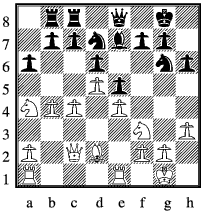
|
| Jack Healings v Derek Whitehurst after 18 Qc2 |
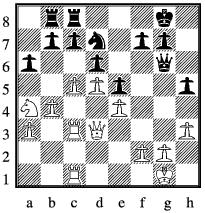
|
| Jack Healings v Derek Whitehurst after 27 ... h5 |
30 bxa6 bxa6, 31 Qe3 An immediate Rc6 is very effective, though this move has future uses.
31 ... Rb7 More protection for the c-pawn and preventing Qa7. Jack uses this to enable him to exchange the knights, his own having sat on the rim for some time.
32 Nc5 Nxc5, 33 Rxc5 Rcb8 A natural doubling of rooks on an open file
34 Rc6 Qe7, 35 d6 More aggressive than the materialistic Rxa6
35 ... Qd7, 36 dxc7 Rc8, 37 Qc5+ Kg8
38 Qxe5 Rb5, 39 Qd6 Qxd6, 40 Rxd6 1-0

|
| Jack Healings v Derek Whitehurst Final position after 40 Rxd6 |
Derek is old enough to have downed his fair share of pints, but in chess terms is less experienced than Jack as he has only joined Fenton this year.
Many low graded players swap material at virtually every opportunity in the misguided belief that this guarantees at least a draw. Stronger players like this, as it gives them the chance to simplify to a materialistically equal but positionally won endgame in a risk free manner. By allowing tension to build these two have generated a more interesting game and are adapting a style which in due course will allow them to trouble stronger opponents.
Yes, it is possible to find stronger continuations than those played, but the same is true of RR's games, and he is nearly 100 grading points stronger than this pair. It is also fair to say that Jack won because of his co-ordinated queenside attack rather than through superior opening preparation. Opening knowledge means that early in the game you should place your pieces on sensible squares, but as the number of people who confess to having difficulty with the transition from opening to middle game testifies, it is the ability to generate a plan that suits the position that separates the good from the merely competent.
comment on this article